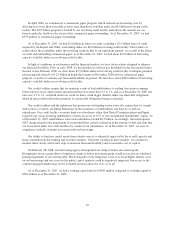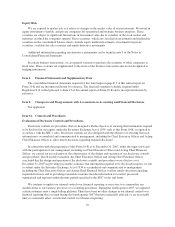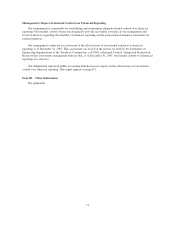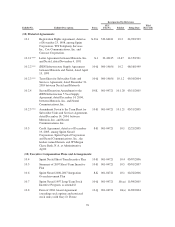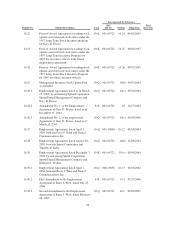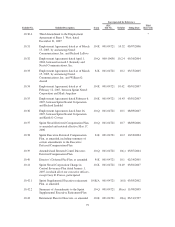Sprint - Nextel 2007 Annual Report Download - page 71
Download and view the complete annual report
Please find page 71 of the 2007 Sprint - Nextel annual report below. You can navigate through the pages in the report by either clicking on the pages listed below, or by using the keyword search tool below to find specific information within the annual report.Cash Flow Hedges
We enter into interest rate swap agreements designated as cash flow hedges to reduce the impact of interest
rate movements on future interest expense by effectively converting a portion of our floating-rate debt to a fixed-
rate. As of December 31, 2007, we had no outstanding interest rate cash flow hedges.
Fair Value Hedges
We enter into interest rate swap agreements to manage exposure to interest rate movements and achieve an
optimal mixture of floating and fixed-rate debt while minimizing liquidity risk. The interest rate swap agreements
designated as fair value hedges effectively convert our fixed-rate debt to a floating-rate by receiving fixed rate
amounts in exchange for floating rate interest payments over the life of the agreement without an exchange of the
underlying principal amount. As of December 31, 2007, we had outstanding interest rate swap agreements that
were designated as fair value hedges.
About 86% of our debt as of December 31, 2007 was fixed-rate debt excluding interest rate swaps. While
changes in interest rates impact the fair value of this debt, there is no impact to earnings and cash flows because
we intend to hold these obligations to maturity unless market and other conditions are favorable.
As of December 31, 2007, we held fair value interest rate swaps with a notional value of $1 billion. These
swaps were entered into as hedges of the fair value of a portion of our senior notes. These interest rate swaps
have maturities ranging from 2008 to 2012. On a semiannual basis, we pay a floating rate of interest equal to the
six-month LIBOR plus a fixed spread and receive an average interest rate equal to the coupon rates stated on the
underlying senior notes. On December 31, 2007, the rate we would pay averaged 8.0% and the rate we would
receive was 7.2%. Assuming a one percentage point increase in the prevailing forward yield curve, the fair value
of the interest rate swaps and the underlying senior notes would change by $21 million. These interest rate swaps
met all the requirements for perfect effectiveness under derivative accounting rules as all of the critical terms of
the swaps perfectly matched the corresponding terms of the hedged debt; therefore, there is no net effect to
earnings and cash flows for any fair value fluctuations.
We perform interest rate sensitivity analyses on our variable rate debt including interest rate swaps. These
analyses indicate that a one percentage point change in interest rates would have an annual pre-tax impact of
$39 million on our consolidated statements of operations and cash flows as of December 31, 2007. While our
variable-rate debt may impact earnings and cash flows as interest rates change, it is not subject to changes in fair
values.
We also perform a sensitivity analysis on the fair market value of our outstanding debt. A 10% decline in
market interest rates would cause a $900 million increase in the fair market value of our debt to $22.9 billion.
This analysis includes the hedged debt.
Foreign Currency Risk
We also enter into forward contracts and options in foreign currencies to reduce the impact of changes in
foreign exchange rates. Our foreign exchange risk management program focuses on reducing transaction
exposure to optimize consolidated cash flow. We use foreign currency derivatives to hedge our foreign currency
exposure related to settlement of international telecommunications access charges and the operation of our
international subsidiaries. The dollar equivalent of our net foreign currency payables from international
settlements was $16 million and the net foreign currency receivables from international operations was
$12 million as of December 31, 2007. The potential immediate pre-tax loss to us that would result from a
hypothetical 10% change in foreign currency exchange rates based on these positions would be insignificant.
69








